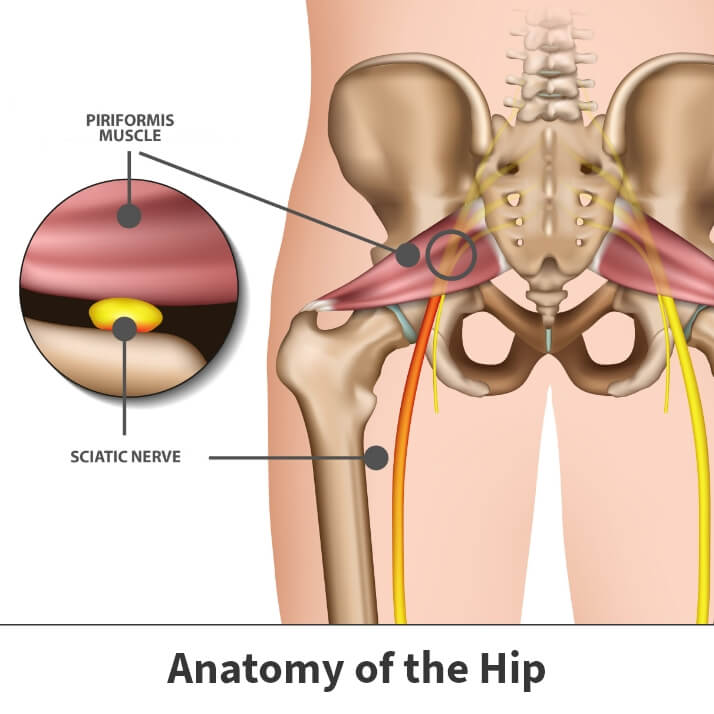Piriformis syndrome
The body’s muscles enable individuals to perform just about every notable physical activity. Sometimes, when certain muscles are injured, they can impact other nearby body parts. One such example is the piriformis muscle, which, when not functioning properly, can result in a medical condition called piriformis syndrome.
Anatomy

The piriformis muscle is located in the buttocks region. Specifically, it begins at the spine’s base and attaches to the thighbones. It is located close to a major nerve called the sciatic nerve.
This muscle plays an important role in enabling persons to rotate their hip and move their legs and feet outward.
About
When the piriformis muscle grows irritated, stretched, or damaged, you may experience full-blown piriformis syndrome along with the associated symptoms.
Causes
Doctors and medical researchers have not yet been able to determine the condition’s exact triggers. They do suggest that the problem may be caused by:
- Damaged or irritation to the piriformis muscle
- Irritation of the surrounding sacroiliac joint or nerve
- Inflammation of the hip joint
- The abnormal tightening of the piriformis muscle
Additionally, bleeding in or around the piriformis muscle caused by sudden injury or illness could bring on the syndrome.
Symptoms
The most common symptom individuals experience is pain.
Symptoms can include:
- Pain and discomfort, usually felt in the buttocks and possibly spread through the thigh and down leg
- Pain that worsens when engaging in actions like climbing stairs and walking uphill
- Sitting for extended periods could cause more intense discomfort
- In more severe cases or advanced cases, the ability to move the hip is reduced

Diagnosis
Unfortunately, there is no specific test used to diagnose piriformis syndrome. A doctor will reach a diagnosis following a thorough medical examination and a review of the patient’s medical history.
Often the condition is discovered when doctors examine patients experiencing the symptoms of other similar illnesses like sacroiliac nerve deterioration or spinal disk injuries.
Occasionally, physicians will use imaging tests like magnetic resonance imaging (MRIs) or computerized tomography (CT scans) to reach a diagnosis.
Treatment
Treatment includes various therapeutic protocols. Fortunately, surgery is only indicated in more severe instances or cases where symptoms are particularly disabling.
Nonsurgical treatment options
Home remedies
The initial therapy doctors often prescribe for most mild to moderate cases is rest. Occasionally, staying off one’s feet as much as possible produces noticeable results. This is especially true of athletes whose activities include significant degrees of running or lunging. Some people find relief after applying heat and ice to the affected hip region.
Medications
The discomfort associated with mild occurrences might be eased by taking either over-the-counter or prescription anti-inflammatory medications. Some patients benefit from muscle-relaxing prescriptions. Persons with more severe cases may notice improvement after receiving physician-administered corticosteroid injections.
Physical therapy
Persons experiencing stiffness or range of motion issues usually find physical therapy beneficial. Working with the physician, a physical therapist evaluates a patient’s condition and creates an exercise program geared towards helping them regain strength in the affected hips and legs.
Learn More About Physical Therapy
Fluoroscopic guided piriformis injection
During this procedure, the patient lies on their stomach, and the physician numbs the skin at the injection site. Then, a fluoroscope is used to help carefully guide a needle into the piriformis muscle. To confirm that the needle is positioned properly, a small amount of contrast dye is injected. An anesthetic and steroid medication is injected into the muscle when the needle is positioned correctly. The medication reduces the inflammation and, in turn, relieves pain. If the injection is being used for diagnostics, the physician waits to see if muscle pain temporarily subsides after the injection. If it does, it confirms that the piriformis muscle is the source of the pain.
Miscellaneous treatments
Occasionally, doctors will use electrical stimulation therapy. This procedure, known as iontophoresis, involves using mild electrical currents into the patient’s piriformis muscle. Iontophoresis has proven effective in relaxing the muscle and easing a patient’s pain.
Additionally, some medical professionals have administered Botox. The paralyzing effects of small Botox dosages are believed to relax the piriformis muscle enough to ease associated discomfort.
Prevention
While it is almost impossible to prevent every instance of piriformis syndrome, individuals are encouraged to take certain preventative actions, including:
Using Proper Form When Exercising – A large percentage of cases occur in athletes participating in sports requiring a significant amount of running and lunging. Quite often, this is so because they fail to use proper form.
By executing simple activities, such as stretching before competitions, continually maintaining good posture, gradually increasing their intensity levels, and playing on even surfaces, one’s chances of developing piriformis syndrome decline significantly.
Videos
Related specialties
- Anterior Hip Replacement
- Avascular Necrosis (Osteonecrosis)
- Groin Strains & Pulls
- Hamstring Injuries
- Hip Arthroplasty
- Hip Arthroscopy
- Hip Dislocation
- Hip Flexor Strains
- Hip Fractures
- Hip Hemiarthroplasty
- Hip Impingement Labral Tears
- Hip Muscle Strains
- Hip Pointers & Trochanteric Bursitis
- Iliopsoas Tenotomy
- Labral Tears of the Hip (Acetabular Labrum Tears)
- Osteoarthritis of the Hip
- Osteoporosis
- Pelvic Ring Fractures
- Sports Hernias (Athletic Pubalgia)
- Thigh Fractures
- Thigh Muscle Strains
